Your Cart is Empty
Customer Testimonials
-
"Great customer service. The folks at Novedge were super helpful in navigating a somewhat complicated order including software upgrades and serial numbers in various stages of inactivity. They were friendly and helpful throughout the process.."
Ruben Ruckmark
"Quick & very helpful. We have been using Novedge for years and are very happy with their quick service when we need to make a purchase and excellent support resolving any issues."
Will Woodson
"Scott is the best. He reminds me about subscriptions dates, guides me in the correct direction for updates. He always responds promptly to me. He is literally the reason I continue to work with Novedge and will do so in the future."
Edward Mchugh
"Calvin Lok is “the man”. After my purchase of Sketchup 2021, he called me and provided step-by-step instructions to ease me through difficulties I was having with the setup of my new software."
Mike Borzage
The Edge: Yuri Alexander’s Shadows
May 28, 2013 4 min read
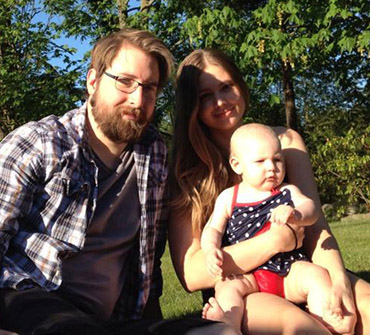
Novedge: Tell us a bit about who you are and what you do
Yuri Alexander: My name is Yuri Alexander. I'm 28 years old. I live near Seattle, Washington. I live with my wife, 8 month old daughter, and our dog, and I have been focusing on Computer Graphics since 2007, specifically realtime art for games.
I've been doing art in one form or another most of my life. I worked in graphic design after high-school, but when I discovered Computer Graphics, something clicked. The mix of technical and artistic scratches all of my creative itches, and it's been a field I've loved since then.
After being laid off from a graphics design position, I made the choice to put my effort into getting involved in the games industry, which is a goal I've been after for the last three years.
Novedge: What is a recent project that you worked on?
Yuri Alexander: My latest piece, Shadows, was a personal piece, and perhaps my favorite so far. It was also my first finished foray into photo-realism, and one of my first serious attempts overall at rendering. I chose to do it because I've been watching the skill-sets between games and movies converging, and I felt that having some familiarity with traditional renders and shaders would be good experience and would give me some problem-solving flexibility.
My conception for the piece was a woman standing in dark, with moody lighting and realistic shaders, with an unnamed presence hovering behind her. I knew going in that if I wanted to do the piece correctly, I would have to learn a good deal more about materials and about photography.
My favorite part of the process was detailing. In games, you are working with a limited budget. Most of the time you are aiming to create something that looks good from a distance, and presentable up close. True details that require effects, high polygon counts, and large texture sizes are generally off-limits.
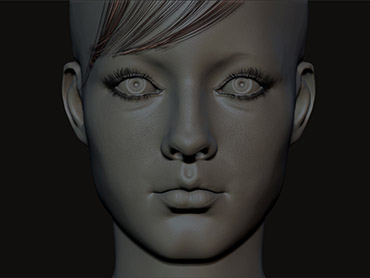
A good deal of the piece ended up being straight trial and error, or the brute force method. I would create, render, learn from what was and wasn't working, and then go back into ZBrush and Photoshop and Maya and preserve the good while I whittled away at the bad. In the end, I had to try out quite a few material setups, lighting rigs, and compositions, before I found something I liked.

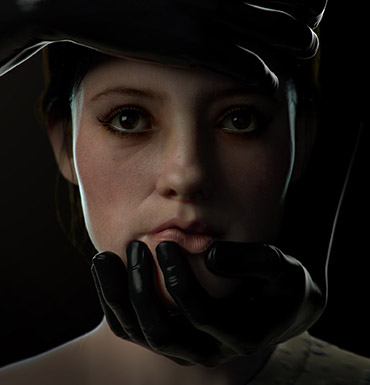
Novedge: What software do you use?
Yuri Alexander: I typically start all of my projects in Silo2. I learned Silo back before I had gotten into Maya, and although many of it's tools are present in the latter, to me, Silo is poly modeling at it's fastest and least encumbered. I use it to establish base meshes and do preliminary UV layouts, and also later in the process for checking game-res meshes and texture work.
For high-poly sculpting, I use ZBrush. I've used other clay modelers, and for texturing I still prefer Mudbox, but the mix of organic and hard-surface tools in ZBrush means that I can get 80-90 percent of my work done in a single application, which keeps me moving and focused on the art, and not necessarily the technicalities or the tedium of transferring between task-specific applications.
If I'm rendering, I use Maya and V-Ray, and sometimes Mental Ray. I find that both engines excel at different tasks, but because a lot of my work is character focused V-Ray is my go-to.
If I am creating a game-res character, then I use Silo and Xnormal. Silo is a perfect for tweaking meshes and modifying UVs, and then exporting to Xnormal for bake.
Finally, for texturing, I use Photoshop. For game-res models, I find Ndo2 indispensable, and dDo is becoming quite a tool as well. While I texture, I prefer to tweak and view my materials in either Marmoset Toolbag or UnrealDK.
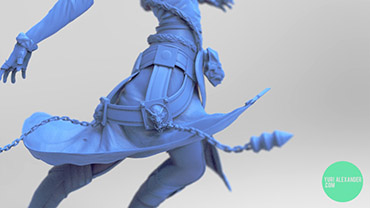
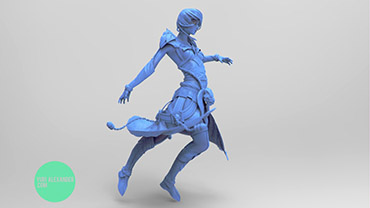
Novedge: What inspires you?
Yuri Alexander: I think like most or many artists I'm inspired by just about everything I come into contact with. Specifically, though, I have an appreciation for writing. Writers live and die by style and creativity. In CG, sometimes it is enough to discard both style and creativity, and simply recreate the world detail for detail through the lens of a computer. My favorite CG artists and the ones who inspire me, are those that use the medium to push reality, and show us something that cannot or should not exist, or show us something that does exist in a way that we hadn't considered.
I also appreciate architecture, and, if I wasn't pursuing games, I think I'd want to be in arch-vis.
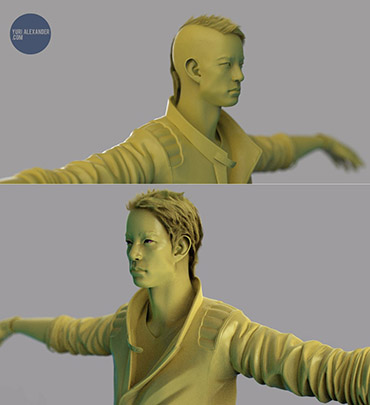

Novedge: What are the rewards and challenges of working freelance?
Yuri Alexander: The biggest reward is that I get to be home with my daughter full time. To me that outweighs every con of freelancing, and there are some big ones.
Keeping yourself on task can be difficult even with a quiet house. But with a baby learning to walk and play, it can be even harder. Freelancers also have to be good money managers, because the income is sporadic and can turn lean, and planning for those times is essential.
I appreciate the variety of projects I get to be involved with. At once I can be working on a game-res character or prop, and also getting 3D scan-data to work with and modify, or doing a random bit of graphic design. It allows me to be more scatter-brained than if I was concentrating on one single piece of a larger pipeline.
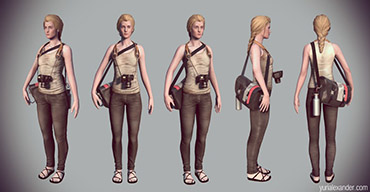
Novedge: What's next for you?
Yuri Alexander: I'm excited right now to be working with a small company on a 3D scan and print project. While I can't say too much about the project itself, I've been interested in scanning and printing for a couple of years. I'm glad to be getting the experience, especially as 3D printers are becoming more mainstream.
See more of Yuri's work on his website.
Connect with Novedge on Tumblr, follow us at The World is 3D.
Related articles
Also in NOVEDGE Blog

Enhance Your Designs with VisualARQ 3: Effortless Geometry Extensions for Walls and Columns
April 30, 2025 8 min read
Read More
MecSoft Unveils RhinoCAM 2025 and VisualCAD/CAM 2025 with Enhanced Features
March 08, 2025 5 min read
Read MoreSubscribe
Sign up to get the latest on sales, new releases and more …





